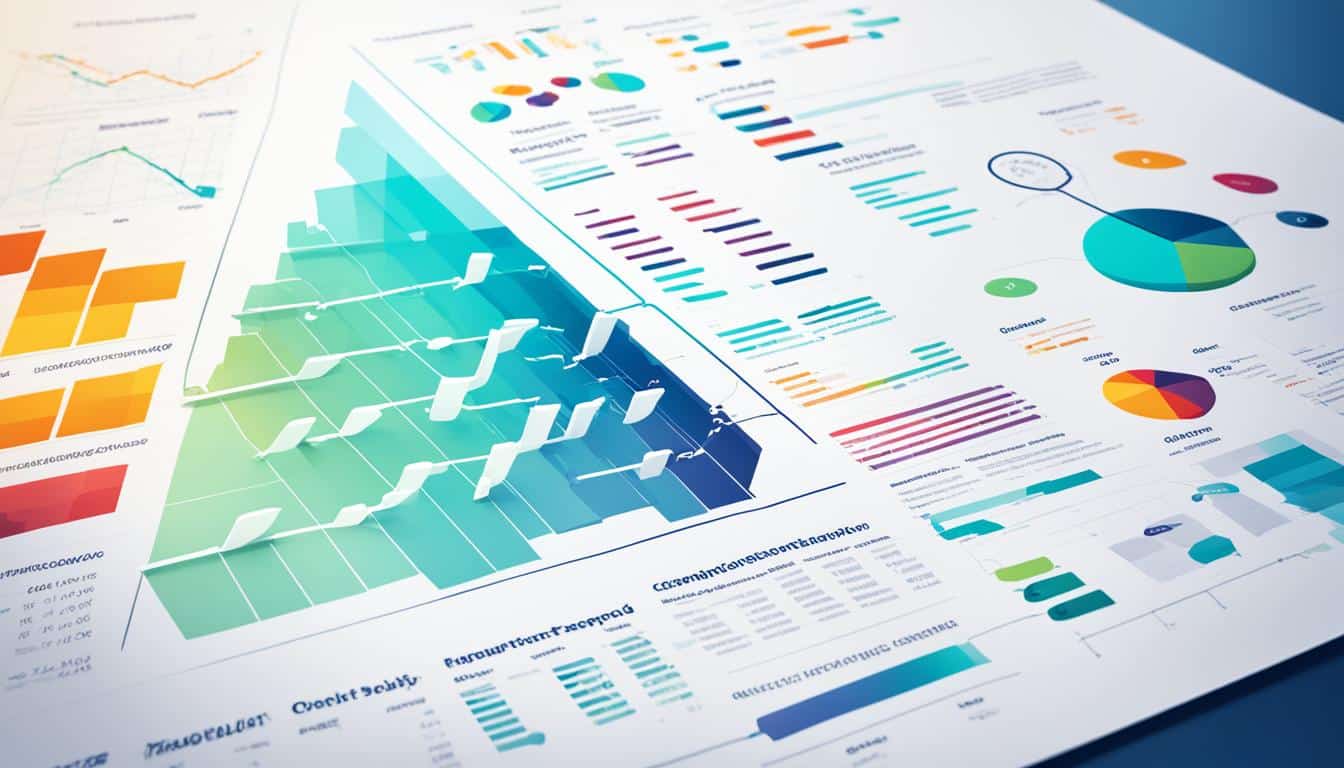Menu

Around 80% of businesses use market research to understand how they’re doing and what customers like. This shows just how important market analysis reports are in today’s business world. These reports help organisations by showing them market trends, what customers want, and who they’re up against. With this information, companies can make smart choices. They help spot chances for growth, see and avoid risks, and get the most from their investments.
Market analysis reports are key for businesses wanting to grasp the industry’s lay of the land. They offer deep insights into how customers act, what competitors do, industry shifts, and market trends. Industry analysis reports and statistical analysis reports help companies cut through a sea of data. They let firms find the gems and ditch the irrelevant info.
Now, let’s dive into what market analysis unveils. A good report paints a clear image of the business world. For example:
Also, industry analysis reports are like strategy handbooks for firms. They focus on areas such as:
Statistical analysis reports are praised for turning big heaps of data into something useful. Think about the insights we get from:
| Metrics | ttDetails | t
|---|---|
| Average Revenue | tt$5 Billion | t
| Businesses Operating | tt1,000+ | t
| Market Size | tt50 Million Potential Customers | t
| Success Rates | tt65% | t
| Advertising Costs | tt$2 Million per Campaign | t
When companies use industry analysis reports and statistical analysis reports, they get an edge. They can spot market shifts early, tweak their plans quickly, and serve customers better.
Market research is all about collecting and interpreting data about markets and competitors. Every business needs this to find out what’s important to customers. It helps them make good decisions based on facts.
Market research is about talking to your potential customers and studying what they do. We call this primary research. It includes doing surveys, interviews, and watching people. Secondary research looks at information that others have already found. This can be from government reports, industry studies, and more. Both of these ways help to get a clear view of the market.

Market analysis looks at what’s happening in the industry and who are the customers. It also checks where a business stands compared to others. Knowing industry trends helps businesses stay ahead. Understanding your customers well is also key. Competitive analysis is about seeing how well you’re doing compared to others.
Market research has two main types: qualitative and quantitative. Qualitative market research looks at why people buy things and what they like. This includes focus groups and interviews. Quantitative market research uses numbers. It helps spot trends and see how big or small something is. This is through surveys and number crunching.
There are also hybrid market research methods. These use both big data and more in-depth looks. Using a mix of strategies can give a fuller understanding. It helps businesses make smart choices and stay competitive.
Companies do market research to understand their market better and find customer needs. This helps in making business intelligence reports that guide important decisions. Market research is key for strategies, brand perception, and measuring how well investments do.
Market research has come a long way from just face-to-face chats about ads. It now includes focus groups, phone and online surveys. Companies use these methods to keep ahead in a fast-changing market.
Primary research sees direct investigations via focus groups and questionnaires. It gets detailed insights. Secondary research looks at already available data from things like government surveys. This paints a bigger picture.
One big pro of market research is finding new business chances and spotting risks. Knowing what customers like helps companies adjust products and marketing for more satisfaction. This boosts loyalty.
It gets even better when companies know exactly who their customers are – like their ages and incomes. This info makes targeting more precise. So, marketing doesn’t reach the wrong crowd.
| Reasons for Market Research | Percentage of Companies |
|---|---|
| Understand customer needs and behaviour | 72% |
| Identify customer demographics | 68% |
| Analyse purchasing behaviour | 85% |
| Anticipate market trends | 59% |
| Measure customer satisfaction | 82% |
Market research also helps companies avoid risks by spotting possible bumps. For example, around 60% of new products don’t hit the mark. It shows how crucial it is to know what customers really want.
Businesses focusing on customers tend to make more money. That’s because they meet customer needs better. Understanding what customers want is really important.
Lastly, market research does way more than just helping with new products. It measures how well things go, keeps employees happy, and helps in making smart choices based on facts. With 88% of businesses valuing this, using solid business intelligence is key to lasting success.
Market research is key for all types of businesses. Whether a company is selling to other businesses (B2B), to customers (B2C), or doing both (B2B2C), understanding markets helps. They use this knowledge to meet their goals and tackle challenges.
In the B2B world, knowing the market well is crucial. Companies look into things like how big their market share is and what their competitors are up to. About 77% of them do this. They often work with experts such as Isurus. They help businesses in fields like technology, business software, and finance learn from market research. This insight is vital for making their strategies better, running more efficiently, and staying competitive.

Companies selling directly to customers are keen on understanding what the customers want and how they act. A large number of them, around 82%, use market research for this purpose. They check on consumer satisfaction and what consumers need. Firms like Pollfish and Suzy are major players here. They offer research that brings data from millions of consumers worldwide. This helps in testing ideas, looking at competition, and knowing who the customers are. Thanks to them, companies can design products and marketing that better fit what customers are looking for.
Then there’s Attest, boasting a vast respondent base of 125 million consumers. It gives these B2C companies lots of useful data. This data keeps companies informed about trends in the market and changes in consumer behaviour.
Companies that combine B2B and B2C models also rely on market research. They aim to fully understand the market they are in. With about 83% deeply involved in research, they study everything. This includes customer satisfaction, the latest market trends, and the strength of their brand. Their goal is to make the customer experience better, improve their supply chains, and make people more loyal to their brand.
Through their detailed research, they get a full picture of their market. This helps drive business improvements and new ideas in the market.
In retail, market research is crucial for understanding key growth and competitiveness factors. We will look at three main areas: customer insights, market trends, and brand evaluation.
To shape effective strategies, it’s vital to know how customers behave. Tools like focus groups and surveys help gather information. This lets companies understand what their customers want, how satisfied they are, and how loyal they are.
Knowing these things helps businesses tailor their offerings. So, they can meet customer needs better.
It’s important to spot opportunities in market growth. This involves looking at trends and sources like government data. Understanding past benchmarks helps make future decisions smart and proactive.
Online research can now spot trends and preferences quickly. This helps businesses stay ahead.
Knowing how customers see your brand compared to others is key. It involves using focus groups and surveys.
These reports help improve brand awareness and how well it performs. Regular checks on brand perception help companies improve their strategies. This is to meet customer expectations and maintain a strong market position.
| Market Research Aspect | Method | Purpose |
|---|---|---|
| Customer Insights | Focus Groups, Surveys | Gauge customer behaviour analysis to improve satisfaction and loyalty |
| Market Trends | Secondary Research, Predictive Analysis | Identify market growth opportunities to stay competitive |
| Brand Evaluation | Branding Research, Perception Reports | Maintain and enhance brand perception among competitors |
Market research methods help us get vital information for planning. There are two main types: primary and secondary research.
Primary research methods directly collect data. This includes:

Secondary research uses existing data like reports and studies. It helps understand the market broadly without starting from scratch.
Tools like social media listening are key. They show how research methods keep improving by using real-time online data.
Organisations use a mix of these methods to find hidden needs and plan better marketing. Both types of research give clues for smart planning.
Businesses need to understand market trends to stay ahead. Detailed reports help spot new trends. This lets companies make better decisions based on what might happen in the market.
Finding new market trends is key. These trends can change whole industries. Procter & Gamble saw how customers were valuing social causes more. They acted with their #LikeAGirl campaign, boosting their brand and leaving rivals behind.
But not all companies see these changes. Barbie, from Mattel, lost to Bratz because it didn’t follow what customers wanted anymore. This shows how important it is to listen to what customers and society are saying.
Looking ahead is crucial in business. Using past data, companies can try to guess what’s next. This helps with creating new products, spotting dangers, and finding ways to do better. For instance, understanding what younger customers like can help target them better.
Looking forward also helps change whole industries. New technologies, like how we talk to each other, can change how brands reach out. This means keeping up with trends in messaging and social media is a must for success.
| Market Trend Topic | Example | Impact |
|---|---|---|
| Demographic Shifts | P&G’s #LikeAGirl Campaign | Shifted Brand Positioning |
| Failure to Adapt | Mattel’s Barbie vs Bratz | Loss of Market Leadership |
| Technological Trends | Consumer Engagement Modifications | Industry Reshaping |
| Communication Trends | Social Media Messaging Changes | Brand Success Influence |
The big consultancy companies and tools like Google Trends help analyse market trends. Using these with feedback from customers can show what the market needs. This information is solid ground for making important business choices.
Knowing your competitors well is key for any business. It helps you see what they’re doing right or wrong. This way, you can make your own plans even better. It’s like a game plan for being more successful.

To really understand your competition, you need to dig deep. Look at their online presence, how they set prices, and what customers think. There are smart tools like Brand24 and Ahrefs that can help you do this.
There are several important parts to a competitive analysis. Here’s what you might find in one:
It’s not just about looking at numbers. Talking to people involved can also give you a clear picture. By mixing different research methods, you get a fuller view. This helps you know where you stand compared to others in the market.
| Competitor | Pricing Strategy | Market Share | Customer Feedback |
|---|---|---|---|
| Apple Inc. | Premium Pricing | 27.4% | High Satisfaction |
| Samsung Electronics | Competitive Pricing | 21.7% | Moderate Satisfaction |
| Huawei Technologies | Value Pricing | 15.8% | Low Satisfaction |
By really looking into your competitors, you can learn a lot. You understand where you can improve. This process is not just about finding flaws. It’s about seeing chances to be better and grow. This can lead to making smarter choices for your business.
A market analysis report gives vital insights for planning. It includes key elements to fully understand market dynamics.
Executive summaries highlight key findings. They give a quick look at market conditions and what’s ahead. These summaries are for making swift, smart decisions.
An industry overview helps everyone understand the market. It talks about market size, what consumers are willing to pay, and future revenues. The report also looks at what customers want and why, giving a complete picture of market trends.
SWOT analysis is vital in market reports. It looks at a company’s strengths, weaknesses, opportunities, and threats. This helps businesses see what they’re good at and where they can grow.
With a detailed market analysis, businesses can understand their market better. They can see trends early, avoid risks, and make better plans. Regular analysis keeps them at the top of their game.
Doing an industry analysis means looking closely at the market. We check the industry growth rate, its size, and trends. This helps us see the competition and understand how the market is moving.

It’s important to know who buys what and why. Understanding this helps in marketing and creating better products. We look at big companies too, to see what they are good at and where they struggle.
Market analysis also makes managing risks easier. It keeps us up to date with changes and helps us predict what’s next. This way, we can make smart choices and spot opportunities.
We use numbers (like sales forecasts) and ideas (like what people care about) in market analysis. Doing this every year makes sure we keep improving. It tells us what to work on, so our plans fit what people want.
Steps for Conducting Industry Analysis | Impact on Business |
|---|---|
|
|
Getting good and relevant data is crucial. We use surveys and discussions, plus online info and reports, to learn a lot. Even if this has limits, it’s key for smart choices.
Today’s market is always changing. Business intelligence (BI) is key for smart business planning and decisions. BI brings together data from different places like your own files to info from the market and social media. This gives a full picture of what’s going on. It helps companies spot changes and react quickly to new trends or rivals.
BI lets companies turn data into useful knowledge. This helps predict what customers will do next and what the market may look like. This way, businesses can change their strategies early. This avoids making big wrong guesses that can be very expensive. BI also looks at what competitors are good or bad at. It helps create plans that are better than theirs and looks ahead to problems that might come.
BI offers tools like analytics dashboards and data visualisations. These tools make sense of big data and predict what might happen. They help companies get to know their customers better and make them happier. By keeping an eye on markets and what people like, businesses can find new chances and trends early. This helps avoid missing out on good opportunities.
For the best use of BI, it’s important to have clear goals and the right tools. Also, data needs to be accurate and all in one place. Staff should be trained well to understand the data. Keeping everything up to date and making sure people work well together is also beneficial. Following these steps helps businesses stick to their plans and stay ahead of others in the market.
In market research, statistical analysis is key for pulling out real insights from data. It looks at what kind of data we have, how they connect, makes models, tests if they are true, and uses the findings in business plans. This helps drive success based on facts. By doing this, companies can find patterns and predict what’s coming in the market really accurately.
Descriptive statistics are important. They tell us about data through things like average, middle value, and the most common. This lets us see the big picture. Inferential statistics then take these details to make conclusions about a bigger group. They use methods like checking how certain factors relate or testing our guesses. This makes sure our plans are based on solid facts, not just guesswork.
Statistical analysis is also big in deciding who to sell to, or market segmentation. It helps look at how people buy, so companies can aim their marketing better. This means their ads or promotions hit the mark more often. It also makes seeing if ads work much easier. By doing this, companies get better at choosing what to do, how to talk to customers, and knowing what the future might hold in the market.
Reading data through these methods is a sturdy base for making choices in business. It means we don’t just guess. For research with consumers or between businesses, the size of what we study matters. For smaller groups, we use details to describe the situation. For bigger groups, we use these details to say what might happen overall. This way, we spend money smarter, avoid waste, and get more from what we put in, making the business run better.
Market research is a methodical way to gather and understand data about markets, rivals, and industries. Its goal is to find insights that help in making wise choices.
It looks at the industry, the market you’re aiming for, and the competition. These aspects give a full view of what the market needs and what others are doing.
There’s both talking to people (like from surveys or interviews) and looking at the numbers (statistical analysis). Each has its own role in understanding the market.
By understanding what the market wants and how customers see their brand, companies can find new opportunities and avoid risks. It helps them decide where to focus their efforts.
Companies from all sectors, whether they sell to other businesses, directly to consumers, or through both, use it. They pick methods based on what they specifically need to know.
Businesses often look into what customers want, the market’s future, and how their brand compares to others. This info helps them adjust their plans and keep up.
Research uses both talking to people and looking at data. Whether it’s by interviews or crunching numbers, the goal is to learn and make informed choices.
These reports spot what’s new in the market and guess at future trends. Businesses can then make plans to stay ahead, looking at what the data suggests.
This is all about knowing your competition – from what they do well to where they struggle. It helps businesses see what they can do to stand out.
An overview of the main findings, a look at the industry as a whole, and a SWOT analysis are all important. They help in making smart strategic plans.
Analysing an industry means sizing it up, seeing how it’s changing, and who’s in it. Also, looking at how tech and the economy might change things.
These reports take raw data and turn it into something usable. They use tools to help businesses see what steps they should take next.
Stats help researchers understand what the numbers mean. By digging into the data, businesses can make smarter choices with more certainty.